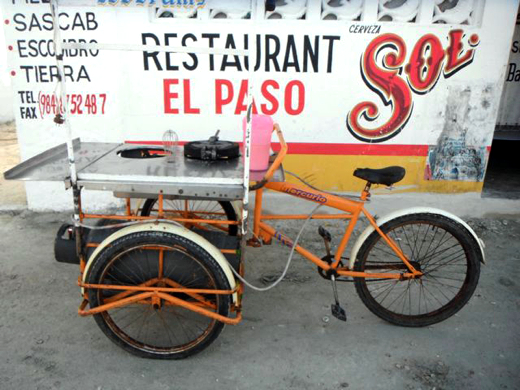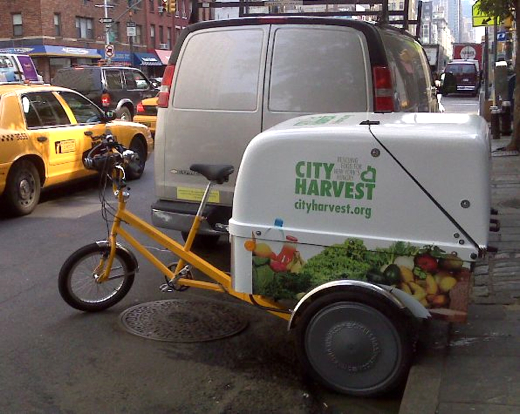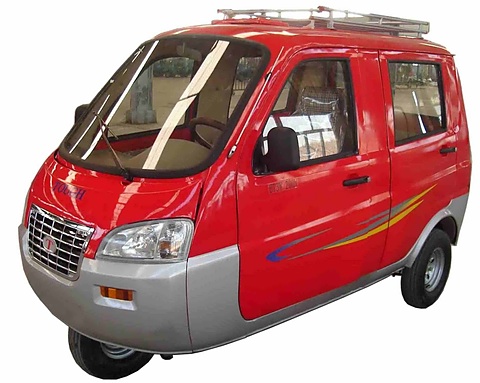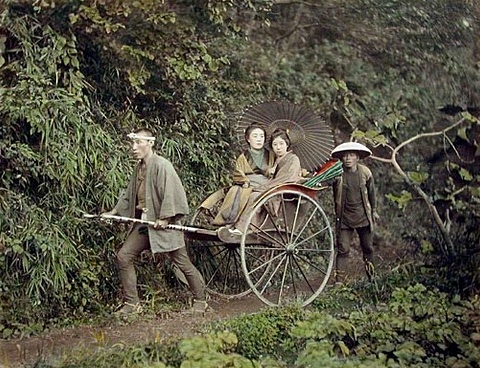By Albert on 4 January 2012 for Club Orlov -
(http://cluborlov.blogspot.com/2012/01/rise-of-tricycle-pushcarts.html)

Image above: A tricycle pushcart serving crepes in From original article.
"Even in backward mining communities, as late as the sixteenth century more than half the recorded days were holidays; while for Europe as a whole, the total number of holidays, including Sunday, came to 189, a number even greater than those enjoyed by Imperial Rome. Nothing more clearly indicates a surplus of food and human energy, if not material goods. Modern labor-saving devices have as yet done no better."
- Lewis Mumford, Myth of the Machine, 1967.In rural México, the number of holidays competes with the number of workdays to see which will find more space on the calendar. Not that the people don’t work, mind you, just that they like to keep hours at any given task as brief as possible, to maintain perspective. As in most agricultural regions of the world, diversity and entrepreneurship is ingrained. When times are especially tight, this instinct goes into overdrive. I have been wintering in a small Mayan fishing village that is part of a natural reserve and like most villages in México it is laid out on a New England-style town grid. There were no ancient Roman master planners or 1950’s city engineers that surveyed these grids.
Nearly all were spontaneous extensions from a single spine road that sent off perpendicular ribs at regular intervals, and those sent off cross-lanes at approximately the same intervals—usually 6 or 8 homes on a side—that created the matrix. Grids like these, as the Egyptians, Greeks, Chinese and Romans understood, enhance the interactions amongst people and encourage a free flow of products, services and information. Living on one such street, all of them unpaved here, I have noticed a discernible uptick in the number and variety of pushcarts.
Here they are called tricyclos. In other places—Denmark or Holland, for instance—modern pushcarts are “cargo cycles.” They can take different forms but the most common is what is known in the bike world as tadpole or front-load trike—2 wheels in front and 1 wheel in the back.
These are ideal for food vendors or pedicabs which require frequent interactions with the scene on the street. A world leader in trike evolution is Christiania, the 800-member urban ecovillage in Copenhagen. Their company, began in 1976 as a small cottage industry to support the alternative community. Today Christianabikes is transnational in reach and constantly improving its designs. For long-hauls, it has low-slung cargo bikes. For vendors like those in Mexico, it has a simple tadpole design that can be customized to meet virtually any use.
What we see in Mexico are mostly Chinese-made clones of Christiania’s original design, or Mexican fabrications of the Chinese fabrications tacked together in local welding shops. Creations like these, which date back a century or more, should be acknowledged to be ‘open source’ by now. What struck me is that I cannot recall a time in the past decade that I have been observing these vendors when there were more of them. Call it a sign of the times, but every few hours another passes by the front of my house, shouting out what he or she is selling. In the morning its newspapers and fresh, hand-made tortillas.
Around lunchtime is it fresh garden vegetables, epizote, bread and other kinds of unprepared food. There might be a tricycle for fruits and juices, another for tomatoes, onions and peppers, another for potatoes, beans and rice. By late afternoons they may pass by with fresh sweetbreads, steaming hot tamales, or corn on the cob.
A man with his tricycle grinding stone offers to sharpen machetes, knives, scissors, shovels, or any other sharp objects. A man with a blender (12V but it could as easily be pedal-powered) makes cups of shaved ice with sweet corn or coconut. You can buy a tricycle brand-new, assembled, already painted in taxi colors of orange and white, and be ready to take a fare straight from hardware store to wherever they are going. The price of a new Chinese-built trike is 3200 pesos, about US$229.32 at today’s rates. The board that goes across the bars for a seat was salvaged from the trash at no cost, but perhaps some cushioned fabric is sewn over to help you through the potholes.
Typically a fare pays 20 pesos ($1.43) for up to a 10-block ride. I asked a tortilla vendor who plies a regular daily afternoon route how much he sells in an average day. “100 kilos” is what he said. His corn tortillas sell for a 3-peso mark-up over the tortilla factory (and there are three of them within a 5-block radius). So if he sells 100 kg, he makes 300 pesos per day, enough to pay for the tricycle in just under 11 days. Perhaps his wife has a masa roller and automated oven at home and he makes his own tortillas and the margin is even better.
Stopping by the largest of the tortilla factories in town — a one-room addition to a family home, which now employs three women from outside the family to turn corn meal masa into machine-stamped tortillas — I inquired how many tortillas they make in a typical day. “Ocho o nueve,” she said, meaning eight or nine metric tons — 8000 to 9000 kilos — and remember, this is just one of three within a short distance, and many people prefer to make their own at home.
The entrepreneurial drive explores for available niches and fills them. Many of these factories supply restaurants and grocery stores. Retail home sales pass through bulk buyers at the tortilleria, like my local trike man, who do just fine with the small margin people are willing to pay for the convenience of not walking around the corner. I noticed that my man sometimes gets lucky and lands a really big sale, however. Maybe someone is throwing a big party (and this happens often) and needs 20 kg. Or a tendajón finds itself short on a holiday weekend and buys 50 kg. His route is pretty small, just a few blocks, but if his son could run his trike in the mornings, or a second trike in the afternoon when he is making his rounds, perhaps he could extend his family’s range and double their earnings.
Then again, as I’ve seen, he’s not interested in that, preferring to live quite adequately on 300 pesos per day ($21.50) in a town where the average unskilled worker makes even less than that. Or perhaps he has another job already and is just enlarging the family’s income by putting in a few extra hours while schmoozing with his neighbors. For me, I’d rather save 3 pesos and ride my bike a couple blocks to the tortilleria, but that’s mainly because, being a writer, I need excuses to force myself out of my chair. As times have become tougher for average people, I’ve also noticed more homes along my bike route opening their front rooms to make tendejóns or comidas economicas.
A comida economica provides a home-cooked meal with table service, giving the buyer a plate of whatever the family is making that day. A tendejón is an informal home store. It might have home-grown pigs, chickens or eggs for sale, or garden produce. It shares the same root word, tener (to have), as the more formal store or mini-mart (tienda), but whether for legal reasons or just wanting to keep it more neighborly, a tendejón is an unpredictable collection of wares in someone’s living room, next to their Christmas tree and fluorescent blinking statute of the Virgin of Guadelupe. Between the tendejón and the tienda lie the more formal abarrotes, or package stores, which usually sell cold beer, insect repellent and junk food.
These are usually under a residence or in an adjoining building to the family’s principal dwelling. There are one or more abarrotes, tendejóns and tiendas on nearly every block. Tricyclos are a common sight in much of Yucatán Peninsula, as they are in Asia, Africa, South America and other parts of the two-thirds world. In the United States you mention a tricycle and people think of Monty Python or Laugh-In. In the global south they are multifunctional and ubiquitous. You see them as fishermen’s friends, beach-roving gear-buckets for surfers, portable crepe parlors, bellhop cabin service, and the poor man’s moving van.
Low-tech Magazine, an on-line compendium, describes many novel uses for pedal power, from archival scans of Sears Catalog pages circa 1892 to a modern recumbent cargo quads. Corn grinding, water pumping and sewer-system cleaning are all potentially portable, pedal-powered services. These are niches that will likely be explored in the South far sooner than when people in North finally decide to come down off of their high horses and get a third wheel.
Cargo Bikes Deliver Food
By Barbara Kessler on 12 September 2008 for Green Right Now -
(http://www.greenrightnow.com/kabc/2008/09/12/cargo-bikes-deliver-food-for-city-harvest-and-help-the-hungry-in-nyc)

Image above: A City Harvest enclosed cargo trike in NYC. From original article.
It’s not just for hearty commuters and weekend racers anymore. With the energy pinch on, people are finding more uses for two- or three-wheeling, whether it’s puttering to school or the grocery. Even businesses are finding ways that bikes can solve problems.
Take City Harvest in New York City. The food rescue agency collects leftovers and unwanted produce from farmer’s markets, restaurants and groceries, and delivers it to various agencies and soup kitchens serving the poor and displaced. Since it opened as the first food rescue organization (in 1982), City Harvest has grown and grown, and today it operates 17 refrigerated trucks that collect food all over the city.
Make that 17 trucks sitting and idling in a whole lot of traffic, particularly the portion of the fleet that serves Midtown Manhattan, a free world mecca of idling and traffic congestion. Meanwhile, many of City Harvest’s donor vendors, who give their leftover sandwiches, donuts and salads at the end of the day would sometimes have to wait for those trucks to get to their store by closing time. It could be touch-and-go.
City Harvest, searching for a way to get to the food faster and more efficiently began eyeing bikes. They’re used to courier documents and small packages all over NYC. Maybe they could address the efficiency issue and also reduce their carbon footprint by increasing their foot power?
The group found a way when they contracted with Revolution Rickshaws, which fitted three three-wheel bikes with cargo compartments that could carry up to 500 pounds of food, said Jennifer McLean, vice president of operations for City Harvest.
Instead of big trucks slogging away, “the biker is able to jet over there and not get stuck in traffic,” Ms. McLean said. “It’s constant pedal and pick up and pedal and pick up.”
Of course, the group had to hire fit drivers for the new cargo bikes (they had to pass physicals), and the bike food pickups are restricted to more than 20 but less than 50 pounds. But once three bikes were on the road, City Harvest was able to reassign some trucks to routes in the boroughs, making that end of the operation more efficient as well.
So far everyone’s happy with the new arrangement, which has cut waiting times, gas costs, carbon emissions and traffic frustrations, Ms. McLean said. The newly hired bikers, all former bicycle couriers, have been muttering a bit about the adjustment to the three-wheel machines, she said, but they’re generally in a great mood at the end of the day because they get thumbs up all day long from those who see they’re on a mission.
Now if only the need for that mission weren’t so great. The group expects to distribute about 23 million pounds of food this year, turning it quickly to poverty agencies so that the leftovers are used within a day or two.
Spiraling food and fuel prices are putting higher demand on those serving the poor, and bringing new clients, some of whom are looking for their first ever free meal or a grocery bag of food.
“We’re seeing people emailing us,” Ms. McLean recounted, (they’re saying) ‘I have a college degree, I have a wife and kids, I need food’.”
Three Wheeled Wonders
SUBHEAD: There are plenty of alternatives out there. Look at the evolution of the rickshaw.
By Juan Wilson on 27 June 2008 for Island Breath -
(http://islandbreath.org/2008Year/09-access_transport/0809-28AlternativeAutos.html)

Image above: A motor Tricycle rickshaw sedan by Qinai Motor Limited
Throughout India, China and much of Asia there has been a tradition of human powered vehicles generally called rickshaws, that evolved from foot power to pedal power.

Image above: A hand tinted photo of human poowed rickshaw from 1886. See Wikipedia for more.

Image above: a modern variant of pedalled side-mounted bicycle on rickshaw frame.
In recent decades have employed piston power. The motorbike now has been attached to the rickshaw more and more sophisticated vehicles. There have been several niches of vehicle need served by this technology including the sedan (see above), the van, the pickup truck, etc.

Image above: A motor Tricycle pickup rickshaw by Qinai Motor Limited
The vehicles illustrated above are the product of an Indian manufacturer, Qinai Motors Limited, a company with less than 500 employees. Their vehicles are aerodynamic and designed to satisfy a more "western" aesthetic than some other manufacturers like Dee India Overseas.
Detailed Product Description Engine type: 1-cylinder, 4-stroke, water-cooled Displacement (ml) : 198. Transmission Way: Axle Transmission: 4 Forward and 1 Reverse Dimension (mm) : 2850*1350*1660 (9.3 long x 4.5 wide x 5.5 feet high) Bore*Stroke (mm) : 64*63 Roted Net Power [kw / (r / min) ]: 10. 3 / 8000 (14hp @ 8000rpm) Maximum Net Torque [Nm / (r / min) ]: 13 / 7000 Idle Speed (RPM) : 1500 Lubrication type: pressure spray Fuel tank capacity (L) : 12 (3 gallons) Fuel efficiency (L / 100km) : <3. 5 (> 67mpg) Start method: electric Ignition: CDI Clutch Method: pedal operation and Adjusting Braking distance / initial speed30km / h: <=6. 5m Minimun turning diameter (m) : 6.0 (20 ft) Brake. (F / R) : disk / drum Net Weight (KG) : 400 (880 lbs) Front Suspension: Hydraulic Spring Rear Suspension: Complete / Hydraulic Spring Ground cleance (mm) : 170 Tire: 5. 00-10 Wheel base (mm) : 1150 Axle Base9mm) : 1850 Maximum Load (KG) : 500 (6 persons) Max Speed: >60 kmh (37 mph) We are the company that specialized in selling motorcycles, scooter, three wheeler (motor tricycle, auto rickshaw) , E-bikes, ATV, and different type of trucks. What is more we have the electric vehicles now and they are really very popular. We have our own factory and it is the leading manufacture which enjoys high reputation in these fields. |
Electric rickshaws are available too. Along with the golf-cart I suspect that small will be beautiful and standard on the American road sooner than most think. Some pedalled ecterically assisted rickshaws are being marketed towards westerners that look much like the rickshaws of the past. Welcome to the future.

Image above: electrically assisted rickshaw with solar panel by Bluebird Electric Rickshaw
Se also:
Ea O Ka Aina: The Chinese Wheelbarrow 1/4/12
.
No comments :
Post a Comment